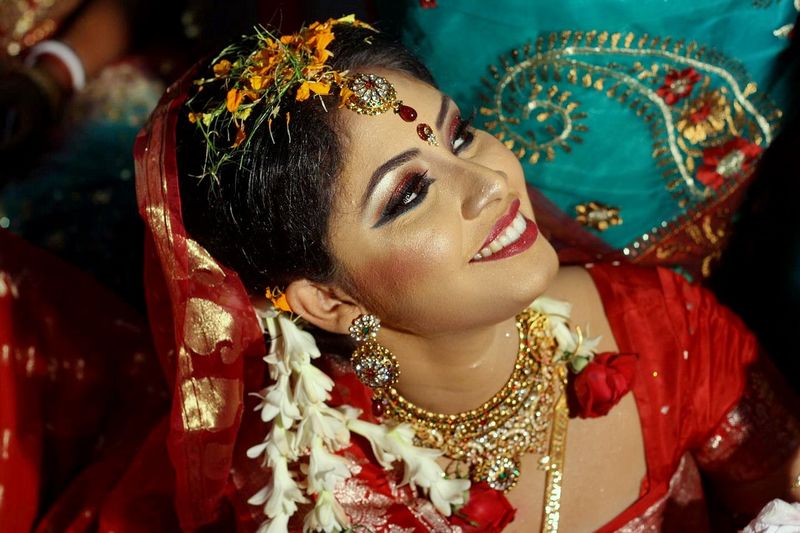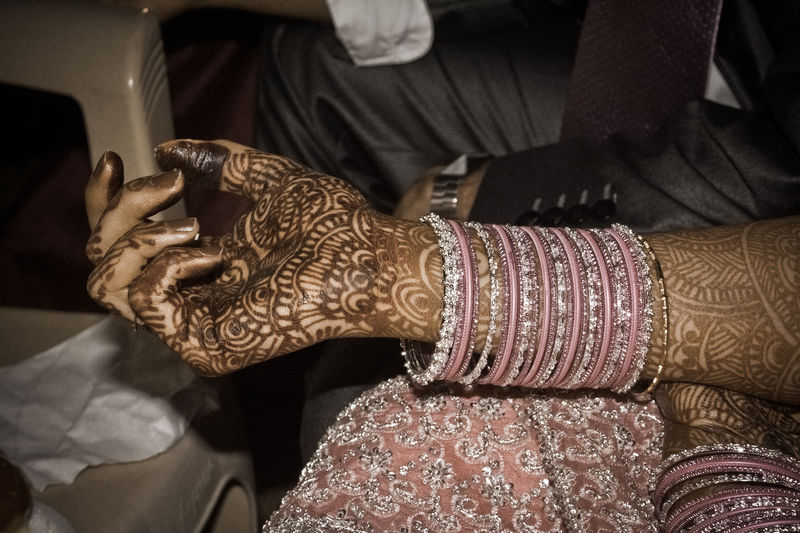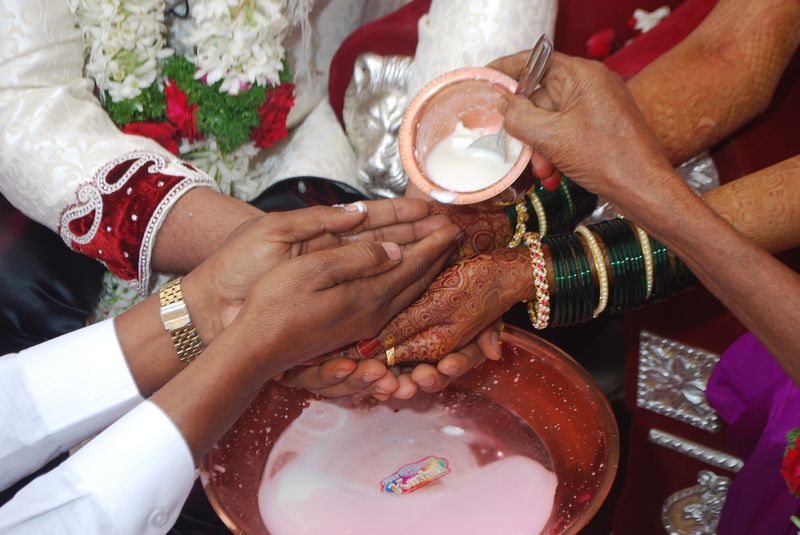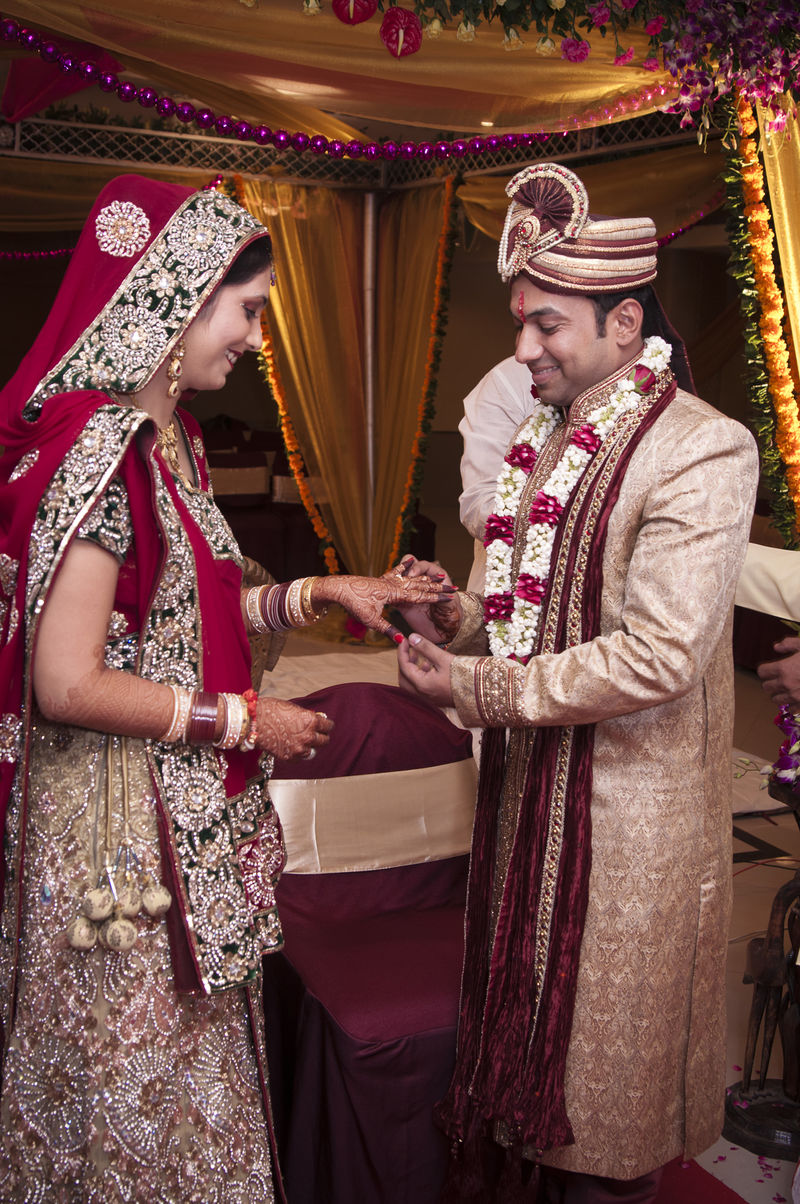Hindu Wedding
Hindu weddings are joyous events that can last up to five days, involving numerous ceremonies rooted in scripture ("shastra") and varying by region. Key rituals include the "baraat" procession, where the groom's family arrives at the bride's home, and the "kanyadaan," where the bride's father gives his daughter to the groom. The ceremonies emphasize unity and commitment, highlighted by the couple walking around a holy fire and taking seven vows ("Saptapadi").
Hindu wedding
Hindu wedding ("vivaha", "vivaah") is a joyus event. It can last up to 5 days. All of its parts are based on "shastra" (scripture).
Not all hindu weddings are the same. Some resources mention eight different weddings. Here is an example.
Brahma marriage is the ideal wedding from the point of religion. It is the most popular in India. Bride's father finds a groom and makes a proposal at the meeting of two family members and cousins. This is sort of engagement.
The couple gets married in the vedic ceremony. In the nort of India this ceremony is knowns as "vivaah sanskar". People in the south of the country have "kalyanam".
It is imposible to mention all the ceremonies present at Hindu weddings. There are many various regional differences. Still some ceremonies are observed in all communities.
A groom and his family form a procession ("barat") and go to the bride's home. Her family members set a welcoming ceremony "swagatam". They perform the "Aarati" ritual and give away sweets.

Every Hindu bride wears "solah shringar". This term includes 16 types of jewellery ("jhoomars" (earings), a toe ring etc.) and make-up elements like for example "kajal" eyeliner used for enhancing bride's eyes.
A Hindu bride must take a bath in the combination of oils, sandal power and various other substances. She traditionally wears a red dress.

Before the wedding ceremony bride's hands and feet are traditionally decorated with henna or mendhi tattoo. Nowadays henna can be worn by a groom too.
On his head a groom wears the wedding turban or "safa". The shape of this turban and materials used in its making vary a lot. The "safa" is usually decorated with a feather like decoration known as the "sarpech".
A groom is traditionally wears a coat-like "sherwani" and "churidar" trousers. Leater "mojari" shoes are mainly worn in the north of India.
According to the Hindu beliefs nine planets of the solar system have positive influence to the couple. That is why a prayer called "graha shanti" is chanted.
People go to the place where the wedding ceremony will be held. For everyting to pass smoothly all present pray to Lord Ganesh.
The bride is who arrives next. This is called "Vadhu Aagman". The bride is lead by her maternal uncle to the wedding mandap. This temporary structure includes four pillars covered with a layer of cloth, leaves etc. Bridesmaids and men accompanying the groom arrive too.
It is important to mention that the bride and groom are first separated with a piece of cloth. This cloth is a symbol of individual lives they had before the wedding.
The next ceremony is Mangalashtakam starts with chanting Manglmantras. Bride and Groom put a flower garland on each other. This act is known as the "jaimala". A pundit explains them the meaning of wedding ceremony and "Grihastha Ashrama" ("Married Life").

"Kanyadaan" is a ceremony where the bride's father leads his daughter to the groom and then holds her hand. During this act the "kama-sukta" ("hymn of love") is spoken.
After that the father expresses his wishes that his daughter and her husband will have life set on love ("kama"), traditional moral values ("dharma") and be financially secured ("artha"). The groom has to promise three times that he will fulill these wishes.
There is also a ritual that includes the "varmala". It is a thin rope made of 24 pieces of cotton. These pieces symbolizes various parts of life. The "varmala" is put around the couple.
During "Panigrahana" both bride and groom sit. The groom holds bride's hand. "Rg" vedic mantra is chanted.
At the beginning of the "Mangalsutrabandhanam" a groom gives the necklace called "mangalsutra" to his bride. This necklace is a symbol of love and luck.

The groom puts little bit of kumkuma powder on the bride's forehead. The bride puts the chandan tilak on the groom's forehead. After that the couple exchanges wedding rings. Groom's mother or sister ties the bride and groom with a marriage knot.
During "Vivaah Homa" ritual the bride and groom ligths the holy fire called "agni". This fire symbolizes kind of witnesses in the whole ceremony. What is more the couple will from that moment one use in everyday prayers to some Gods like for example Santati.
The couple then walks around the holy fire four times. A bride's brother is with them. This is known as "Agni Pradakshina". After that the bride will move to the left of the groom. This act symbollically shows that from that moment on she is part of the groom's family.
Hindu wedding reaches its peak in the ritual called "Saptapadi". It has seven parts. Various vows in Sanskrit are exchanged between a bride and a groom. In some communities local language is used too.
In the north of India many weddings inlcude the tradition known as the "Baasi Jawari". Single bride's sisters and female cousins steal groom's shoes. To return them they ask for a ransom which is money or some present.
In some Hindu communities people also have a wedding tradition known as "Dhruvdarshan". The pundit ask the newlyweds to look at the pole star. It is a stable position. So this star symbolize the stable relationship.
It is not easy to describe what dishes are served at the Hindu weddings. All sort of savoury snacks or "chaat" are available. In the north of India there is lot of tandori meat, spreads. In the coastal parts of India or on islands people prepare dishes based on seafood.
People gathered at the wedding bless the newlyweds. They bow to them. Guests throw flower petals at the them. They leave to their new home.
Many traditions exist in the period after the wedding. The one is a must. The "Satyanaryan Pooja" must be chanted. It honours an incarnations of Vishnu. The Hindus believe that this pooja helps the newlyweds to have children soon.
When a bride is leaving her home she throws some rice and coins over her head towards her former home. This should keep the place wealthy.
Groom's parents welcome the bride by putting a pot filled with grains at the entrance to the house. When arriving there a bride pushes the pot with her right foot. This is a symbol of the wish for the prosperous future. The couple then chants some poojas like for example Shri Ganesh.
References
Hindu wedding
https://en.wikipedia.org/wiki/Hindu_wedding
Hindu Wedding Information
http://www.hinduwedding.info/marriage-ceremony.html
Wedding mandap
https://en.wikipedia.org/wiki/Wedding_mandap
Hindu Wedding Traditions
https://www.theknot.com/content/hindu-wedding-traditions
Nadya, The Essential Guide to Hindu Weddings: Wedding Traditions
http://thebigfatindianwedding.com/2014/the-essential-guide-to-hindu-weddings-wedding-traditions
Solah Shringar
http://www.culturalindia.net/weddings/wedding-traditions/solah-shringar.html
Hindu traditions
http://weddingdetails.com/lore-tradition/hindu/
Hindu Wedding
http://www.culturalindia.net/weddings/regional-weddings/hindu-wedding.html
Gary Singh, The Hindu Wedding Ceremony
http://entouraaj.com/hindu-wedding-ceremony/
Photographies
Kanyadaan (photo by SunilChavan, Pixabay)
https://pixabay.com/en/henna-india-wedding-marriage-908462/
Henna or mendhi tattoo (photo by Wolfgang Maehr, Flickr)
https://www.flickr.com/photos/njyo/4257418675/
Hindu bride (photo by kbanik79, Pixabay)
https://pixabay.com/en/bride-bangladesh-wedding-ceremony-1741838/
The couple exchanges wedding rings (photo by Kunjan Detroja, Wikimedia)
https://commons.wikimedia.org/wiki/File:Ring_ceremony,_Indian_Hindu_wedding.jpg
We are India-Custom-Tours rawpixel.com / CC0